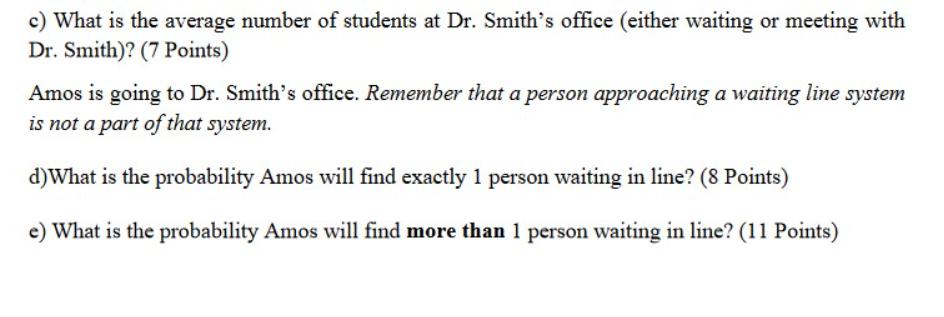Answered step by step
Verified Expert Solution
Question
1 Approved Answer
Dr. Smith is a teacher in the education department who serves one student at a time throughout the day. He can serve an average



Dr. Smith is a teacher in the education department who serves one student at a time throughout the day. He can serve an average of 8 students per hour and the students arrive at his office at a rate of 3.6 per hour. a) What is the average time a student spends at Dr. Smith's office (either waiting or meeting with Dr. Smith)? (7 Points) b) What is the probability that 4 students will arrive at Dr. Smith's office in the next hour? (7 Points) c) What is the average number of students at Dr. Smith's office (either waiting or meeting with Dr. Smith)? (7 Points) Amos is going to Dr. Smith's office. Remember that a person approaching a waiting line system is not a part of that system. d) What is the probability Amos will find exactly 1 person waiting in line? (8 Points) e) What is the probability Amos will find more than 1 person waiting in line? (11 Points) This is another queueing theory problem. Dr. Smith's office can be modeled as an M/M/1 queue, where the arrival rate is = 3.6 students per hour and the service rate is = 8 students per hour. a) The average time a student spends at Dr. Smith's office (either waiting or meeting with Dr. Smith) is given by the formula W = 1 / (-X). Plugging in the values for and , we get W = 1 / (8-3.6) = 0.1923 hours, or about 11.54 minutes. b) The number of arrivals in a fixed period of time follows a Poisson distribution with parameter Xt, where t is the length of the time period. In this case, t = 1 hour, so the parameter is At = 3.6*1 = 3.6. The probability of k arrivals in this time period is given by the formula P(k) = (At)^k *exp(-t) / k!. So, the probability of 4 arrivals in the next hour is P(4) = (3.6)^4 *exp(-3.6) / 4! = 0.1742. c) The average number of students at Dr. Smith's office (either waiting or meeting with Dr. Smith) is given by the formula L = / (-X). Plugging in the values for and , we get L = 3.6 / (8-3.6) = 0.6923. d) The probability that there are n customers in the system (i.e., either waiting or meeting with Dr. Smith) is given by the formula P(n) = (^/)^n * (1 -/u). So, the probability that Amos will find exactly 1 person waiting in line when he arrives is P(1) = (3.6/8)^1 * (1-3.6/8)= 0.3375. e) The probability that Amos will find more than 1 person waiting in line when he arrives is given by the formula P(more than 1 waiting) = 1 - P(0 waiting) - P(1 waiting). Using the formula for P(n), we have P(more than 1 waiting) = 1 - P(0) - P(1) = 1 - [(3.6/8)^0 * (1-3.6/8)] - [(3.6/8)^1 *(1-3.6/8)] = 0.405.
Step by Step Solution
★★★★★
3.59 Rating (152 Votes )
There are 3 Steps involved in it
Step: 1
a The average time a student spends at Dr Smiths office either waiting or meeting with Dr Smith can ...
Get Instant Access to Expert-Tailored Solutions
See step-by-step solutions with expert insights and AI powered tools for academic success
Step: 2

Step: 3

Ace Your Homework with AI
Get the answers you need in no time with our AI-driven, step-by-step assistance
Get Started


